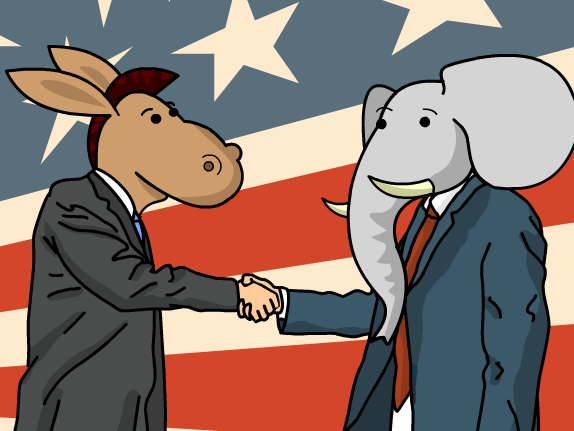
American politics are all about political parties but few people are aware of the history of political parties in the United States. The lessons I’ve prepared are for 9th grade students in an urban environment. Prior historical knowledge is scarce and the majority are unaware of the political history of the United States. In my lessons I plan to use multiple formats to reach the student and teach them about American political parties.
PRINT
Source 1
Fireside Chat Outlining The New Deal
Bibliographic Information:
Roosevelt, Franklin D. “Fireside Chat Outlining the New Deal .” National Archives and Records Administration, National Archives and Records Administration, catalog.archives.gov/id/197303.
Summary:
The Fireside Chat Outlining the New Deal is an annotated primary source taken from one of President Roosevelt’s speeches that he delivered to the people of the United States during the Great Depression. The source outlines the steps the government would be taking in order to stabilize the economy. In relation to political parties the source is a good example of the transitional shift between the Democratic and Republican parties. The source highlights the Democratic party’s movement towards big government. The article highlights key initiatives such as the Public Works Initiative and the Farming Relief Bill. Both are quality examples of how the Democratic party began to favor big government over minimal government involvement.
Text Complexity:
After analyzing the text and using the StoryToolz function I came up with the following quantitative results. The grade level ranged between grade 11 and grade 16 with an average of 14.3. Although the text contains information that is at a higher level I still think the text can be made approachable to students in the 9th grade with added instruction. Through qualitative analysis I have reached the conclusion that further assistance would need to be provided. The article does contain language features and vocabulary that would need to be addressed. For example, students would need to have general information regarding the Great Depression and the economic functions that surrounded it. I would state that the language functions are moderately complex but not overbearing. I would need to prepare students for the reading with a lesson regarding the Great Depression. Key ideas and terms would need to be defined such as legislation, congress, economics, and economic relief. Overall, the text does present some difficulties for students; however, I would never assign such a reading without thorough preparation. The students would need to be provided with background knowledge regarding the Great Depression and political party stances at the time.
Task & Reader Complexity:
The reading of the fireside chat will serve as an example of how the political parties within the United States shifted ideologies. The text will provide students with background knowledge regarding the political shift during the 1920s and 1930s. The article highlights the shift of the Republican party becoming the more conservative party and the Democratic party becoming the liberal party. The primary source emphasizes the shift within the Democratic Party from favoring small government to large government. Ideally I would use this text (pages 1 through 5) in a compare/contrast activity. Students could compare the Democratic parties ideals in the 1920’s with their ideals during the Civil War. The complexity of the task in comparison to the accessibility of the text is highly contingent on the prior knowledge that would be provided to students. In no way could students be presented with this task without background knowledge being provided. That being said, I know that with the background knowledge my students would be able to approach the tasks and complete the activity with the objective of comparing and contrasting political party shifts.
Source 2
Calvin Coolidge (Article and Video)
Bibliographic Information:
History.com Staff. “Calvin Coolidge.” History.com, A&E Television Networks, 2009, http://www.history.com/topics/us-presidents/calvin-coolidge.
MULTIMEDIA
Source 3
From white supremacy to Barack Obama: The history of the Democratic Party
Bibliographic Information:
voxdotcom. “From white supremacy to Barack Obama: The history of the Democratic Party.” YouTube, YouTube, 7 Nov. 2016, http://www.youtube.com/watch?v=Z6R0NvVr164.
Summary:
The video From white supremacy to Barack Obama: The history of the Democratic Party provides a short in-depth historical analysis on how the democratic party became the liberal political party that it is today. The source outlines the historical viewpoints and shifts within the party such as its views on slavery during the Civil War and its shift to racial activism. The video also highlights the important shifts in how the Democratic party became the party of large government and the Republican party became the party of small government. The video is a quality source that is able to engage students upon viewing while also giving them historical knowledge they may be unaware of.
Text Complexity:
After annotating and analyzing the video using the StoryToolz function I came up with the following quantitative results. The grade level ranged between grade 11 and 13 with an average of 13.1. Although the video contains information that is challenging I still think the video is approachable to students in the 9th grade. Considering that the video is narrated to the students the readability should not negatively impact the students experience with the film. Through qualitative analysis I reached the conclusion that further assistance would need to be provided due to the vocabulary and historical concepts/time periods that the video discusses. For example, students would need to have a general understanding of information regarding the Civil War and the treatment of African Americans during the time period. Students would also need to have an understanding of the Democratic party’s views in the 1920s and 1960s to thoroughly understand the political shift in ideology. I would state that the language functions are moderately complex but not hindering due to the provided narration. I would, however, need to prepare students for the video with background knowledge relating the Civil War, the 1920s, and the 1960s. Key ideas and terms would need to be defined such as Democratic, Republican, economic inequality, discrimination, political policy, manifest destiny, and Trail of Tears. Overall, the film does present some difficulties for students; however, with proper preparation the video is a great tool to explain the ideological shifts within the Democratic party.
Task & Reader Complexity:
The viewing of From white supremacy to Barack Obama: The history of the Democratic Party will serve as an opening activity to foster discussion regarding the shifts in political ideology while also providing students with a visual aid and explanation of historical shifts. The video highlights the racist past of the Democratic party and the current liberal views of the party. The video highlights integral shifts within the party such as the Trail of Tears, the Civil War, the Great Depression, and the 1960s Civil Rights movement. The complexity of the task in comparison to the accessibility of the video is contingent on the prior knowledge of the students. Before teaching the lesson and having them view the video I would need to make sure that the students have prior knowledge of the concepts and time periods being discussed. That being said, as an opener activity the purpose is to facilitate discussion and dispel common historical myths that students may have.
Source 4
How the Republican Party went from Lincoln to Trump (Video)
Bibliographic Information:
voxdotcom. “How the Republican Party went from Lincoln to Trump.” YouTube, YouTube, 20 July 2016, http://www.youtube.com/watch?v=s8VOM8ET1WU.
MULTICULTURAL
Source 5
Teen Vogue: Are You A Democrat or A Republican?
Bibliographic Information:
Pennell, Julie. “Quiz: Are You A Democrat or A Republican?” Teen Vogue, TeenVogue.com, 25 May 2017, http://www.teenvogue.com/story/political-party-quiz.
Summary:
The Teen Vogue quiz Are You A Democrat or A Republican? is a multicultural questionnaire that provides users with questions regarding political affiliation. The questionnaire poses questions regarding gay rights, abortion, taxes, and the role that government should play in the daily lives of citizens. The questions highlight ideological cornerstones that are attributed to the Democratic and Republican party. The quiz highlight the issues that are currently happening in the United States while providing a context of questions that directly relate to the ideological leanings of the parties they represent. The quiz is a quality questionnaire that allows students to think about the issues that are important to them and how their own thoughts align with the Democratic and Republican party.
Text Complexity:
After analyzing the questionnaire using the StoryToolz function I came up with the following quantitative results. The range consisted of grades 8 through 14 with an average of 11.2. Although the questionnaire does contain certain questions that deal with politicized topics, the readability falls within the 9th grade reading level. Through qualitative analysis I reached the conclusion that further instruction would need to be provided. Certain terms and topics would need to be discussed prior to the questionnaire. I would state that the language functions are moderately complex due to some of the topics discussed in the questionnaire. For example, students would need to be made aware of what gay rights are and what terms like pro-choice and pro-life mean. Other terms that would need to be defined are abortion, immigration, environmentalism, and school choice. Overall, the questionnaire is an approachable source that deals with issues that students are interested in. Some preparation would need to be prepared in order for students to understand certain key ideas found within both parties but overall it is an approachable source that deals with current topics.
Task & Reader Complexity:
The questionnaire Are You A Democrat or A Republican? serves as a multicultural source that discusses key issues such as LGBT rights and women’s rights. The questionnaire is approachable to all demographics and serves as a closing activity to engage students. The activity allows students to reflect upon current issues and decide which way they politically lean. The former activities allow them to put into perspective the historical and current issues that each party stands for and how their own opinions fall within those diameters. The complexity of the task in comparison to the accessibility of the questionnaire is contingent on the views of students and how they think the government should impact the nation. Before giving the questionnaire I would state that the quiz is based on a fraction of political issues that are associated with both major political parties and that the quiz is only a small representation of what each party stands for.
Source 6
Political Parties Rap-Smart Songs
Bibliographic Information:
smartsongsmusic. “Political Parties Rap – Smart Songs.” YouTube, YouTube, 20 June 2009, http://www.youtube.com/watch?v=1lt-f3QQ7-A.




